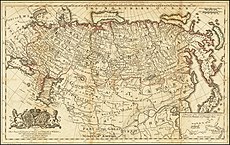Russian Republic
show This article may be expanded with text translated from the corresponding article in Russian. (September 2021) Click [show] for important translation instructions. |
This article relies largely or entirely on a single source. (December 2020) |
Russian Republic Российская Республика | |||||||||||
|---|---|---|---|---|---|---|---|---|---|---|---|
| 1917–1918[a] | |||||||||||
| Anthem: Рабочая Марсельеза Rabochaya Marsel'yeza "Worker's Marseillaise" Gimn Svobodnoy Rossii "Anthem of Free Russia" (unofficial) | |||||||||||
Government Seal: | |||||||||||
 The Russian Republic in March 1917 | |||||||||||
| Capital | Petrograd | ||||||||||
| Common languages | Russian | ||||||||||
| Government | Democratic federal republic | ||||||||||
| Minister-Chairman | |||||||||||
• Sep–Nov 1917 | Alexander Kerensky[b] | ||||||||||
• 1917–18 | none[c] | ||||||||||
| Legislature | Provisional Council (1917) Constituent Assembly[d] (1918) | ||||||||||
| Historical era | World War I/Russian Revolution | ||||||||||
| 8–16 March 1917 | |||||||||||
• Republic proclaimed | 14 September 1917 | ||||||||||
| 7 November 1917 | |||||||||||
| 25 November 1917 | |||||||||||
• Constitution adopted | 18 January 1918 | ||||||||||
• Constituent Assembly dissolved | 19 January 1918 | ||||||||||
| Currency | Ruble | ||||||||||
| |||||||||||
| History of Russia | ||||||||||||||
|---|---|---|---|---|---|---|---|---|---|---|---|---|---|---|
 | ||||||||||||||
|
Prehistory • Antiquity • Early Slavs
Feudal Rus' (1097–1547) Mongol conquest • Vladimir-Suzdal Grand Duchy of Moscow • Novgorod Republic
Russian Revolution (1917–1923) February Revolution • Provisional Government
|
||||||||||||||
|
Timeline 860–1721 • 1721–1796 • 1796–18551855–1892 • 1892–1917 • 1917–1927 1927–1953 • 1953–1964 • 1964–1982 1982–1991 • 1991–present |
||||||||||||||
|
| ||||||||||||||
The Russian Republic[e], sometimes referred to as the Russian Democratic Federal Republic, was a short-lived state which controlled, de jure, the territory of the former Russian Empire after its proclamation by the Russian Provisional Government on 1 September (14 September, N.S.) 1917 in a decree signed by Alexander Kerensky as Minister-Chairman and Alexander Zarudny as Minister of Justice.[1]
The Government of the Russian Republic was dissolved after the Bolsheviks seized power by force on November 7, 1917. Nontheless, a partially democratic election of the Constituent Assembly still took place later in November. On January 18, 1918, this assembly issued a decree, proclaiming Russia a democratic federal republic under the name "Russian Democratic Federative Republic".
On the next day, the assembly had also been illegally dissolved by the Bolsheviks.[2] After their complete seizure of power, the Bolsheviks used the name "Russian Republic" until the name "Russian Soviet Federative Socialist Republic" was officially adopted in the Constitution of July 1918.
The term "Russian Republic" is sometimes used erroneously for the period between the abdication of the Emperor Nicholas II on 3 March 1917 (16 March, N.S) and the declaration of the Republic in September. However, during that period the future status of the monarchy remained unresolved.[citation needed]
Politics[]
Officially, the Republic's government was the Provisional Government, although de facto control of the country was contested between it, the soviets (chiefly the Petrograd Soviet), and various ethnic-based separatists (such as the Central Council of Ukraine). Soviets were political organizations of the proletariat, strongest in industrial regions, and were dominated by left-wing parties. Soviets, whose influence was supplemented with paramilitary forces, were occasionally able to rival the Provisional Government which had an ineffective state apparatus.[citation needed]
The Government's control of the military was also tenuous. Seamen of the Baltic Fleet, for example, had far-left views and openly engaged in political activism in the capital. Right-wing proclivities among the army officers were also a problem – Kerensky's attempt to dismiss Gen. Lavr Kornilov led to a failed coup.[citation needed]
Principal institutions[]
- State Duma of the Russian Empire
- Council of the Russian Republic
- Congress of Soviets
- Russian Provisional Government
- Directorate (Russia)
See also[]
- Russian Empire
- Russian Civil War
- Soviet Union
- Petrograd Soviets
- World War I
References[]
- ^ The Russian Republic Proclaimed at prlib.ru, accessed 12 June 2017
- ^ Ikov, Marat Sal. "ROUND TABLE THE INFLUENCE OF NATIONAL RELATIONS ON THE DEVELOPMENT OF THE FEDERATIVE STATE STRUCTURE AND ON THE SOCIAL AND POLITICAL REALITIES OF THE RUSSIAN FEDERATION". Prof.Msu.RU. Retrieved 9 February 2021.
However, historically, the first proclamation of the federation was made somewhat earlier - by the Constituent Assembly of Russia. In his short resolution of January 6 (18), 1918, the following was enshrined: "In the name of the peoples, the state of the Russian constituent, the All-Russian Constituent Assembly decides: the Russian state is proclaimed by the Russian Democratic Federal Republic, uniting peoples and regions in an indissoluble union, within the limits established by the federal constitution, Of course, the above resolution, which did not thoroughly regulate the entire system of federal relations, was not considered by the authorities as having legal force, especially after the dissolution of the Constituent Assembly.
Notes[]
- ^ Effectively ceased to exist after the October Revolution of November 1917, formally abolished in 1918.
- ^ Served as the prime minister of the provisional government since July.
- ^ Power de facto seized by the Bolsheviks.
- ^ Dissolved after the very first meeting.
- ^ Russian: Российская Республика, tr. Rossiyskaya Respublika, IPA: [rɐˈsʲijskəjə rʲɪsˈpublʲɪkə].
External links[]
- The Russian Republic proclaimed. Presidential Library
- Browder, R. P., Kerensky, A. F. The Russian Provisional Government, 1917: Documents. "Stanford University Press". Stanford, 1961. ISBN 9780804700238
- States and territories established in 1917
- States and territories disestablished in 1917
- Russian Revolution
- Russian Provisional Government
- Post–Russian Empire states
- Former Slavic countries
- Former republics
- 1917 establishments in Russia
- 1917 disestablishments in Russia

